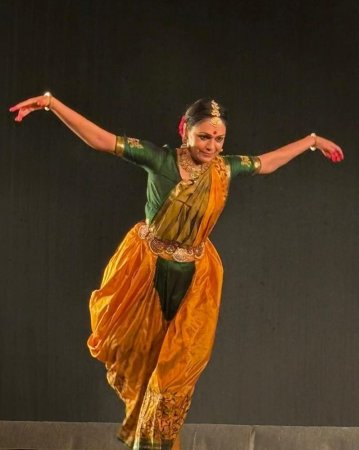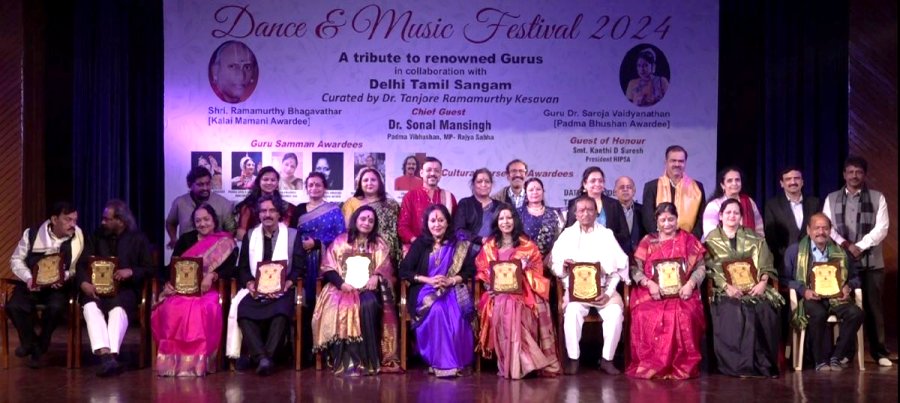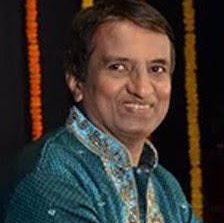
|   |

|   |
Aesthetic Saamya and Guru Samman - Vijay Shanker e-mail: vijaydance@gmail.com January 21, 2025 National Centre for Performing Arts (NCPA) organised the Pravaha festival featuring premier choreographies for three days at the Experimental theatre and Godrej Dance Academy theatre from December 12 to December 14. The first day featured Sevens by Nina Rajarani and troupe in the Bharatanatyam styles, A journey through Kuchipudi Yakshagana in Kuchipudi style by Sreelakshmi Govardhanan, Jaya Jaya Deva Hare in Manipuri style by Bimbavati Devi and troupe. Day two presented Saamya in Bharatanatyam style by Rama Vaidyanathan. Day three featured AbhiRamam in Bharata Nrityam style by Aishwarya Harish, Niyati Vijayita by Revathi Srinivasraghavan in the Bharatanatyam style, Dancing Emptiness in Kathak style by Gauri Diwakar and lastly Dakshina Nayaka in Kathakali style by Sadanam Balakrishnan and troupe. I could attend only Rama Vaidyanathan's exquisite Saamya presentation. SAAMYA - AESTHETIC EXPOSITION OF NATURE AND LIFE Last year, I had witnessed Rama Vaidyanathan's performance in the Lalit Arpan festival in New Delhi and this time at the NCPA. Both the performances have left an indelible impression of a devoted and innovative performer who is always exploring new themes and creative movements which is both challenging and exciting. Hence this could be one of the reasons for her enduring popularity as an enterprising performer and mentor. Saamya was an aesthetic exposition of both nature and life, pertaining to the impact of nature on human life, proving the fact that to maintain a harmonious connection and intimacy with nature is really important for the existence and wellbeing of human life.  Rama Vaidyanathan Through five varied dance compositions, Rama succeeded in portraying the colourful nature, its magnificence, beauty and its close connection with human life, the varied angik movements of the birds, animals, flowers with complete submission to the portrayal of the theme and its philosophical and psychological impact on human life with lyrics taken from Rig and Yajur Veda, Kausitaki Brahmana, Sangam, Kalidas, Surdas, Amir Khusrau and a composition by Vidwan GN Balasubramaniam. Saamya commenced with the picturisation of the Spring season known as Vasant Ritu that forms a fine combination of equanimity and pleasure, equal duration of days and nights. A reference is made to the Bhagawad Gita in which Lord Krishna is described as the lord who is spring of all seasons, hence nature is perceived with its beauty and colourful magnificence. The second dance number was Punaravarthana meaning blooming again, rising or sprouting - the right time to sow seeds, new plants and harvesting, time to celebrate Basant Panchami. Rama's innovative and creative movements depicted the sprouting of the plants, the blooming of flowers and the joyful atmosphere in which birds and animals are frolicking around. Rama succeeded in portraying the complete magnificence of nature in its varied dimensions in amazing beauty, coupled with suitable music of the mridangam and the violin. Kamarogini beautifully combined sensitivity and sensuousness as the arrows of love invoke unabashed and uncontrolled desire for union with one's lover. The heroine anxiously waits to meet her lover. Bahuvarnani described the colourful Rituraj, king of all seasons and queen of everyone's heart, incorporating the play of holi as Radha and Krishna dance with happy abandon with the composition "Kesariya angiya rang doli ji" (Kesariya refers to Krishna - my love, do smear colour on me). The finale number was Apeksha. As the name suggests expectation or hope, the sunshine after winter, hope for equanimity, rejuvenation, bliss and happiness, one should always hope for the best with an optimistic attitude towards life and wellbeing. The dancer signed off as a fine representative of Apeksha and hopefulness. Music and vocal was by Dr S Vasudevan, rhythm, mridangam and tabla by Manohar Balatchandirane, ghatam, kanjira and nattuvangam by Varun Rajashekar, violin by Vishwesh Swaminadhan, narration by Prachi Saathi, costumes by Mohanapriyan Thavarajah and lights by CV Kamesh. GURU SAMMAN BY DELHI TAMIL SANGAM Delhi Tamil Sangam organised a music and dance festival featuring a hundred artistes as a mark of tribute to Guru Ramamurthy Bhagavathar and Dr Saroja Vaidyanathan at their premises in RK Puram on 21 December. The festival was curated by veteran musician Dr Thanjavur Ramamurthy Kesavan and the chief guest for the occasion was Dr Sonal Mansingh. The festival was inaugurated by Anand Patil (IAS).  Guru Samman awardees Besides the cultural extravaganza of music and dance by young performers, the highlight was the distribution of Guru Samman to distinguished mentors. The Guru Samman was bestowed on Shovana Narayan for Kathak, Jayarama Rao and Vanashree Rao for Kuchipudi, Ranjana Gauhar for Odissi, Jayaprabha Menon for Mohiniattam, Kanaka Sudhakar for social service and Bharatanatyam, Rajendra Gangani for Kathak, Shrimathy Madkholkar for Bharatanatyam, musician GS Rajan, Vasanta Shridhar for Bharatanatyam and Sindhu Mishra, ex-secretary, SKP. Delhi Tamil Sangam president R Mukundan and N Kannan were felicitated with Cultural custodian award. Dr Sonal Mansingh praised the efforts of Dr Kesavan in bringing artistes together and honouring them, thereby promoting and propagating Indian classical music and dance.  Vijay Shankar is a Kuchipudi and Kathakali exponent, teacher, bilingual journalist, arts critic and actor. |